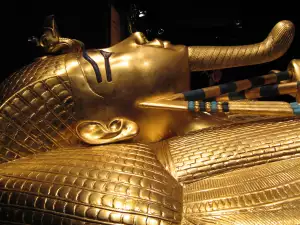Tomb of Tutankhamun

The tomb of Tutankhamun is one of the most popular tourist and historical attractions in the world. The tomb is a part of the precious history of Egypt, which is the father of an entire ancient civilization that became the basis of a modern society. The tomb is a part of the ‘greatest’ outdoor museum in the Valley of the Kings which is near the historic Egyptian village, Luxor.
Tutankhamun was a pharaoh and he managed Egypt between 1361 and 1352 BC. He is one of
many pharaohs that are buried in the Valley of the Kings, which is now probably the greatest historical value and the most visited tourist destination is Egypt.
The whole name is Nebheperura pharaoh Tutankhamun, also known as Tutanhamun (in Egyptology Tooth-Anh-Amun) and was called at birth Tutankaton.
He was an Egyptian pharaoh of the Eighteenth Dynasty. It is a famous fact that he sadly died as a teenager. Tutankhamun ascended the throne at eight years of age and died at the age of 19.
Most professionals and researchers of his death think that it was caused by a strong blow to the head. Some more recent studies indicate that it is a more likely version that his death was caused by necrosis of the left leg, a result after breaking his leg.
Tutankhamun was the last heir of the powerful family that ruled Egypt for centuries. The young king was buried in a gold coffin, the interior is made from red quartzite. The young king was buried with a myriad of fabulous treasures - jewels, precious objects, sculptures and other statues, jars and containers with fragrant aromas.
The tomb of Tutankhamun was discovered in the Valley of the Kings in 1922 and is credited to the British archaeologist, Howard Carter. The tomb of Tutankhamun is the only royal burial found intact from ancient Egypt.
Only a few years ago, Egyptian archaeologists had found baskets and intact clay pots at the tomb of Tutankhamun. They obviously were not detected in the clearing of it 20 years ago last 20th century. The find includes twenty clay pots, sealed with a seal with the name of Tutankhamun. They probably contain seeds and remnants of drinks. In one of the baskets were found dried fruit and eight other - 60 limestone plates with the name of Tutankhamun.

Relatively new archeological finds were discovered in the treasury, located adjacent to the burial chamber. There, in 1922 the British archaeologist Howard Carter found the mummy of Tutankhamun. According to Dr. Zahi Hauas, vessels were likely to contain provisions for the journey of Tutankhamun to the afterlife. These objects were originally discovered by Howard Carter, but have not been opened or removed from the tomb.
For the first time the mummy of Tutankhamun was displayed without a sarcophagus in his tomb near Luxor on November 4th, 2007. In early January 2005, Egyptian scientists examined the mummy of Pharaoh Tutankhamun and announced exciting results from their studies.
The experts concluded unanimously and rocked the scientific community, by concluding that the young pharaoh died of a natural death and was not killed by their approximations, as was previously thought. The version that Tutankhamun died from his head bearing a fatal blow has now been completely dismissed as there is no evidence of skull characteristic lesions. The final results on the cause of death of the pharaoh had to be published until the end of 2005.
In 2010, after examination of the mummy with a medical scanner showed that the most likely cause of death was malaria, combined with infection after breaking his leg.















